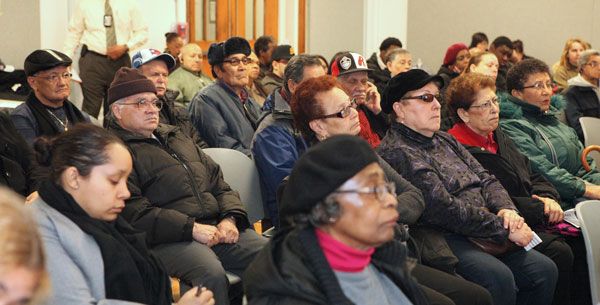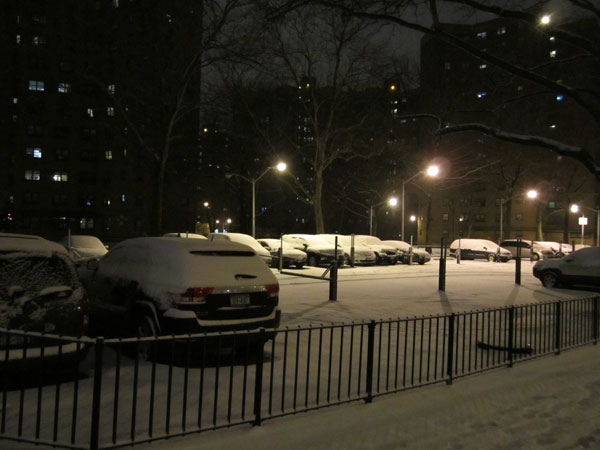
BY LINCOLN ANDERSON | Although local politicians, Community Board 3 and public housing residents are all calling for a slowdown in the process, the New York City Housing Authority is moving full-speed ahead with a plan to allow private “infill development” on eight of its Manhattan sites, including at five complexes in the East Village and Lower East Side. The new buildings would be rental, with a mix of 80 percent market-rate units and 20 percent affordable units.
NYCHA is set to release a request for proposals (R.F.P.) for interested developers late next month. According to a timeline being given out by the city, developers would be selected between August and November. Ninety-nine-year ground leases would then be signed for the parcels.
The infill buildings “could come online in four to five years,” according to Fred Harris, formerly of AvalonBay developers, who is overseeing this NYCHA development project.
Department officials say the scheme could generate $30 million to $50 million annually for the cash-strapped agency. Complexes where the new buildings are constructed would benefit by getting a share of the revenue to use for repairs and maintenance, plus would get emergency backup power in the case of blackouts — which would provide hot water, limited elevator use, security and hallway lighting.
The new units would be permanently affordable.
The city’s plan is to lease sites for development within existing public housing complexes, including Baruch Houses, at East Houston St.; Campos Plaza, at E. 12th St.; LaGuardia Houses, at Madison and Rutgers Sts.; Smith Houses, at South St. and Robert Wagner Place; and Meltzer Tower, at E. First St.
This parking lot at East Houston St. and Baruch Drive would be developed with a new 405-apartment “80/20” building under the plan.
The Baruch site — now a parking lot — would allow one new building of 375,000 square feet with 405 apartments.
The Campos property — currently a parking lot and a basketball and handball courts — would allow a 90,000-square-foot building with 97 apartments.
The LaGuardia Houses parcels — which is right now two parking lots — is earmarked to become two new buildings with a total of 255,000 square foot and 276 new apartments.
At Meltzer Tower, an outdoor seating area now used by the complex’s senior residents would be replaced by a 90,000-square-foot, 97-unit building. At the Smith Houses, there would be two new developments — to be located on the current sites of a paved baseball field and basketball court, parking lot and garbage-compactor lot — comprising more than 1 million square feet and 1,150 new units.
At an Assembly hearing on the plan March 15, assemblymembers pushed John Rhea, the Housing Authority’s chairperson, and Harris for more information about the plan.
Brian Kavanagh, whose East Side district includes two of the affected housing complexes, accused the authority of “hiding the ball” on details about the infill plan.
Rhea said the idea is simply for NYCHA to “leverage one of our most valuable assets — our land.” Based on current zoning law, many NYCHA developments, he said, “have the ability to grow, and the ability to enhance their neighborhoods.”
Added Harris, “These areas are all located in areas that are dense, but we think could be a little denser.”
“Why are we rushing this?” asked Keith Wright, chairperson of the Assembly’s Standing Committee on Housing.
The authority is struggling financially, Rhea explained, having lost $2.3 billion in government funding since 2001, and is carrying an operating debt of $60 million.
A substantial part of the money from the new infill buildings will go toward fixing roofs, elevators, lobbies and boilers and upgrading security in the complexes where the new projects are sited.
“Every penny will go to the capital needs of NYCHA,” Rhea stated. “This represents the single, best way to raise the money — and the time to act is now.”
These capital repairs are separate from the agency’s backlog of apartment repairs, though this number is dropping, Rhea assured.
“This plan is specific to meet these [capital] needs — not the backlog,” he clarified.
The Housing chairperson said NYCHA has been talking about the idea of capitalizing on its land for more than a decade.
He added that the new construction projects “will bring $3 billion in economic activity and money to neighborhoods in need.”
Rhea said NYCHA residents would be given jobs in connection with the construction of the new buildings and then permanently, staffing them.
Rhea said it’s incorrect to dub the infill buildings “luxury housing,” rather, that they would be “mixed-income, 80 percent market rate.”
But Carmen Quinones, a Douglass Houses tenant activist shouted out: “Eighty percent luxury housing!”
Harris said, NYCHA would “receive significantly less” if it increased the number of affordable apartments.
Rhea said NYCHA residents would receive priority for the new lower income apartments and that applicants would have to earn less than 60 percent of area median income — $36,000 for a single person and $54,000 for a family of four. NYCHA does have middle-income residents, but they won’t be eligible for these new affordable units.
In response to accusations that NYCHA hasn’t done an adequate job informing its residents, politicians and the wider community about the plan, Rhea said the authority has been doing outreach, and is currently completing a round of tenant-outreach meetings, and that the plan will also go to local community boards for review. There will also be a second round of community outreach later on, he said.
A Web site on the infill plan is now live at https://on.nyc.gov/landlease , and will eventually let people post comments, though they can’t now.
However, Wright asked, “Will the horse be out of the barn [once the R.F.P is released]?”
“Absolutely not,” Rhea countered, saying, “What we’re trying to do is put down a track [for the horse].”
Kavanagh pushed for details about the height of the new buildings. Harris and Rhea said that would be up to the developers to decide when they respond to the R.F.P. Could they be, for example, 50 stories tall? Kavanagh asked. Rhea said that would be very unlikely since it would result in a “pencil building.”
However, Harris later told Downtown Express that because the new buildings would have to be rental, they would likely not be extra-tall (which is not as cost-efficient), and would be “fatter” — similar to the buildings AvalonBay constructed at Bowery and East Houston St. (including the building housing the Whole Foods Market and Chinatown YMCA and the one across the street adjacent to the Liz Christy Garden).
Kavanagh also said residents hope the new buildings would at least have ground-floor commercial uses, but Harris and Rhea said zoning doesn’t allow it.
A prevailing concern is that the new mixed-income buildings will open the door to privatizing the NYCHA complexes.
“Our headline is ‘Trojan horse,’” said attorney Joel Kupferman , who is representing tenants at the Smith Houses.
BARUCH HOUSES MEETING
As part of the community outreach process, Mon., March 18, Cecil House, NYCHA’s general manager, and Harris gave a presentation to Baruch tenants. About 100 local residents turned out for the presentation, at nearby Bard High School, on the snowy and blustery evening. Many of them have been living in Baruch for decades, if not their whole lives. House kept cool under fire as residents repeatedly peppered him with complaints about ongoing problems at the complex and lack of services, and slammed the new plan.
Baruch tenants complained about “rats as big as horses,” a lack of outdoor benches for seniors, problems with recurring sewage backups on the complex’s grounds and a “temporary sink” plan a few years ago that bombed.
Members of GOLES (Good Old Lower East Side) also protested that NYCHA pays $100 million annually to the city for police patrols, but that this should be free, and that if the agency could keep that money, it wouldn’t need any new infill buildings.
Damaris Reyes, executive director of GOLES and a Baruch resident, objected to the 80/20 breakdown, saying the formula should also include middle-income NYCHA residents.
“You’re saying to us that this is a proposal,” she said. “But ‘proposal’ to us means that we can negotiate. Many of our families are middle-income, being doubled- and tripled-up [in apartments].”
She demanded to know what the market-rate units’ rents would be.
Harris said studios would be more than $2,000 per month and one-bedrooms more than $3,000.
He noted there’s room at Baruch for even more than one new building.
“I’m hoping this will be so successful,” he said, “that in a couple of years you’ll come to us and say, ‘Please, give us another of these wonderful buildings.’”
Regarding concerns about parking, Harris said, the new buildings won’t be required to provide it. NYCHA residents who currently have parking spaces will be able to keep them, Rhea assured.
Councilmember Rosie Mendez noted that letters had been put up falsely saying the Baruch meeting was canceled. As a result, she called for another outreach meeting. House said they’ll consider whether to hold “a supplemental meeting.”
Mendez chairs the City Council’s Committee on Public Housing, which will hold a public hearing on the infill plan on April 5.
Last month, a group of local elected officials, including Kavanagh and Mendez, Congressmembers Carolyn Maloney and Nydia Velazquez, Assembly Speaker Silver, Councilmember Margaret Chin, Borough President Scott Stringer and State Senators Brad Hoylman and Daniel Squadron, as well as C.B. 3 Chairperson Gigi Li, wrote to Mayor Bloomberg and Rhea calling for “greater transparency” on the infill plan and a slowdown on issuing the R.F.P.
Last Friday, the mayor responded, saying that the plan “must be undertaken in close collaboration” with local residents, the community and elected officials, but not indicating there would be any change in NYCHA’s aggressive timetable.
Speaking after receiving the mayor’s response, Kavanagh said in an interview that, in fact, he thinks it is “a good idea” for NYCHA to use its own property this way, but also said he wants to make sure the new buildings “make sense in the context in which they’ll be built and that they’ll benefit the residents in these communities — if they get buy-in from the community.”
Also, he added, “NYCHA has to be more open and accountable than it has been in the recent past.”



























